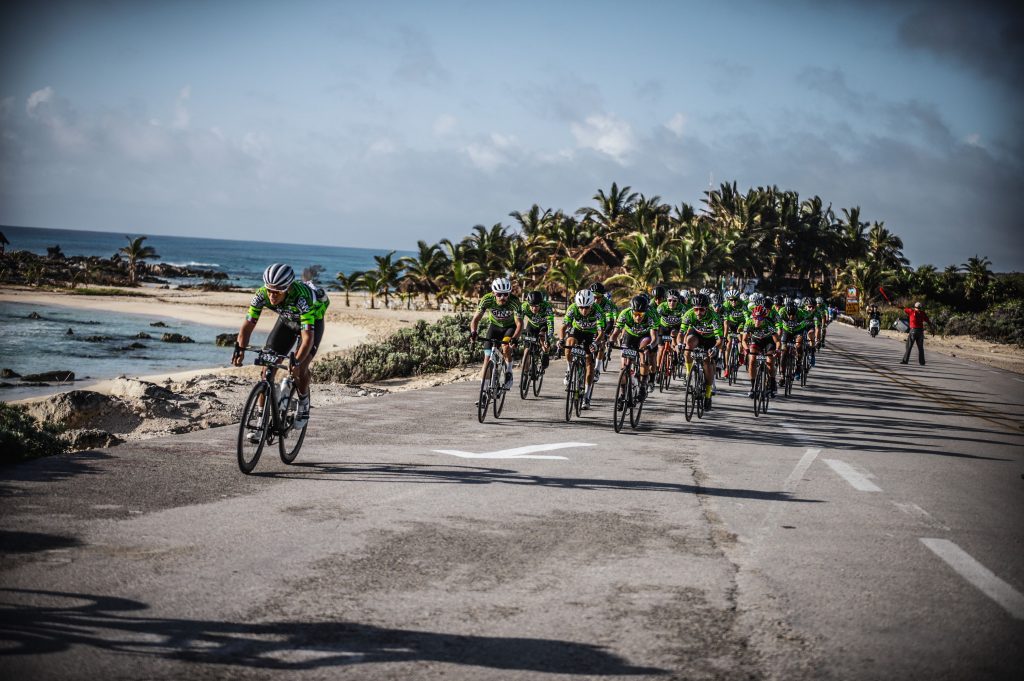Granfondo – The Future Path of Pro Cycling
BY ULI FLUHME
Part and parcel of rethinking cycling’s future in how it develops its fan base, media coverage, sponsorship, and sustainable growth is the development of the riders themselves. In our 2020 whitepaper Rethinking Cycling’s Future, we detailed a future for cycling that eliminated distractions, put fans in the middle of the race with enhanced coverage, and grew the opportunities for sponsorship, all while returning cycling to its exciting roots as one of the most compelling athletic endeavors in existence.

But what of the athletes themselves? On its current trajectory of acting like a traditional television sport, the stories have centered around the sensational, on showmanship, and cycling elements that matter the least to cycling’s core fan base. Ask any casual fan about who led the pack for the majority of today’s stage, and they will scarcely be able to tell you, because the coverage will focus on the names, and when the names make their moves. As the traditional media restraints have tightened like a pair of handcuffs on cycling’s wrists, the sport has bent its athletic strategies to play to the needs of media and has actually discounted and discarded many athletes that have had no gateway to the rarefied air of media coverage. And so, those athletes go without pro contracts, work regular day jobs, and attempt to live the lifestyle of a pro cyclist as closely as possible.
But is that all there is?
The Shifting Ground
Technology is evolving faster than traditional media can keep up. Sport content carriers are dying. In January of this year, NBC announced that it would discontinue the NBC Sports channel. Launched in 1995 as the “Outdoor Life” channel, NBC Sports will not exist beyond 2021. The Tour de France was once the crown jewel of the network. And so, as postulated in our 2020 whitepaper, should cycling put its faith in a medium that can no longer support itself? The answer is still “no” in 2021 – but we are adding another lens. It is the athletes that make the race, but also the racing that makes the athletes. Limited room on the World stage for talented would-be professionals will only get tighter if professional cycling does not adapt and survive the shifting ground beneath it. Professional cycling – the business – is on tenuous ground, and as a result, fewer talented racers will have the opportunity to compete at the highest levels.
The economics of racing without scale is untenable. We have seen amateur road racing – in its long-loop course format disappear. This has happened in Europe and the U.S. But the troubles don’t end there. More and more second-tier and once important professional races are also no longer with us. This is placing an unsustainable financial burden on teams that want to continue to compete as they travel across continents for races that have few spectators and no visibility for their athletes. Amateurs cannot turn professional, and elite amateurs cannot continue to fund their racing (or their teams) without sponsorships, and sponsorships don’t happen without visibility. It’s a downward spiral we must break for the future of our sport.

The Granfondo Solution
Overview
As amateur and second-tier pro racing options have been waning, granfondos have been on the rise. In its purest form, the traditional Italian model of mass-participation, “all-comers” racing puts pros, elite amateurs, and cycling enthusiasts (the fan base) in direct competition. Marathon, triathlon, granfondo all follow the mass-participation model to grow their fanbase through participation, increase their exposure through a much larger group of spectators (meaning more eyes for sponsors), and all operate with something that elite-amateur and second-tier pro racing will never have: scale.
The four points below outline the economic and competitive benefits of granfondo as the future path of pro cycling.
Scale
You may be wondering why economics was not the first consideration. It’s certainly a fair question. But in considering the economics of just about anything, scale is everything. Defining scale as the number of humans it takes to accomplish something, and the number of times a human has to repeat a process is where scale and economics converge. So the easy math here stipulates that it takes as many humans to put on a successful cycling race no matter how many participants there are. To provide technical support, road closures, route marking, aid stations, and security over a 100 mile or 161-kilometer course, takes the same number of police, volunteers, and paid event staff for a field of 5000 as it would for a field of 100. (Multiplied by the amount of time the course is active of course – but at that point, the race is scaling efficiently through the use of repeatable processes over a longer period). Summing it up, this is where small amateur and second-tier pro races struggle, and where properly run granfondos excel.
Visibility
Where scale dictates the ability of a race to be feasible, visibility allows it to thrive. In reaching back to our scale example, a long-loop race with 100 participants brings 100 shoestring budget racers to the race. No matter the stakes, the importance of the race within the standings, it all means the same thing to the local police departments and the local residents. Blocked intersections and an inconvenience for residents for most of the day and the day before for just a few athletes. The costs to the community are the same for the community, and so that drives the costs up for sponsors without the benefit of return on investment. Enter scale, the enabler of visibility. Where scale succeeds, visibility increases. In imagining the same race with 5000 participants, we have now brought a significant source of revenue to the community via tourism, and a significant number of eyes to the sponsors in the form of participants and the families and friends that they bring with them. By putting the fans in the action, the visibility for sponsors is raised by an order of magnitude. The community also benefits as more participants means more fame for the host towns. A successful race will often lead to more visibility within the world of endurance sport prompting more organizers to look at host cities that have been successful.
Finally, granfondo provides a challenging platform for athletes to showcase their skills to sponsors and teams. With the limited opportunities in top-tier racing getting away from local criteriums and showcasing their talent in a format that more closely resembles what athletes would encounter in a top-tier race. With fewer and fewer races of this type happening in the second-tier pro ranks (especially in the U.S.), athletes will need more opportunities to demonstrate that they can stay with the top-tier competition, survive the rigor of a challenging course, and manage their effort over a long race stage. Top-tier competition will attract top-tier sponsors and as the sport evolves, the visibility will prove not only valuable but critical for athletes that want to take the next step.

Development of New Talent
The racing landscape has evolved and degraded somewhat over the years, especially in the U.S. The downside of scale and visibility is that when you don’t have them, the race format needs to change. Rather than evolve forward to granfondo, racing has receded to shorter formats, such as criteriums and circuit races. These condensed formats do have their advantages, however athletes can only develop skills and fitness specifically tailored to the format they race. Rarely do these races include the challenging terrain, swirling winds, and long-course strategies and tactics that make racing so exciting. And so talent that may be best suited to the longer and more challenging courses are instead stagnating as they race short format races because, in the mind of an elite athlete, to compete is to live.
But elites should be given the opportunity to challenge other elite competition, and race within the more traditional pro cycling environment, on a more demanding course. Elite athletes entering granfondos would be able to develop the types of skills that are most critical at the pro level. They would become instantly disruptive in a competitive field that may be more experienced but not as talented. And they could gradually hone their craft creating a name for themselves and becoming more attractive to sponsors and potentially even pro teams. At the very least, the granfondo format would provide them with the competition they need to continue to develop while maximizing otherwise wasted potential. And even if they don’t make it to the pro level, they would be able to compete and demonstrate their skills in a peloton more commensurate with their talents.
It could even be hypothesized that granfondo-developed racers would be harder, tougher, more seasoned pro cyclists, with less dependency on the modern conveniences of team cars, and large team formations. Relying on their individual guile and skills to get them through a race. Learning how to read the pack, create their own strategies and tactics, and become and become a more well rounded and complete bike racer.
Finally, with visibility and scale, more professional cyclists will race granfondos. Sponsored pros need to compete, and they need to compete in a way that keeps them sharp and forces them to use the skills they will need in their usual racing. Granfondo is a perfect proving ground to keep professionals tuned and to keep attracting top elite amateur and second-tier professionals to “race with the best”.

Compatibility with Newer Media Formats
In our 2020 whitepaper Rethinking Cycling’s Future, we outlined a future for cycling without traditional television coverage. For example: putting fans inside the race and creating a media ecosystem that both sustains and enhances the drama of the sport. Granfondo would be a key venue for this strategy. With racers that are unencumbered by complex contracts willing to carry on-board cameras, coupled with continually evolving (and monetized) streaming media technologies, the face of racing could change in a hurry. Borrowing from the model of video game live streaming, granfondo visibility and scale could stretch well beyond the confines of the race course. Added interactivity would encourage race time debate and commentary that would be rooted in the passion of the core fan base. No longer beholden to the sole opinions of the television presenters that spoon-feed this audience cycling in digestible chunks between commercials, fans would be able to watch and learn for themselves how the sport works, how the story unfolds, and how the drama and action are revealed.
The potential number of granfondo stories within the evolving interactive model that is based on the preferences of the fans is staggering. Consider, rather than being confined by the television ratings model, the multi-camera action format would leapfrog the current streaming models that are just traditional television transplanted to a different screen. With users able to choose their camera angle, start a discussion, and watch the story they are most interested in unfold, the fans will pave the way for cycling to evolve.

Overcoming Objections
“But cycling is different. Pros and amateurs racing together doesn’t work.”
Cycling is indeed a very old and very traditional sport. Suggesting pros should race granfondos is often countered with “cycling is different, that wouldn’t work”. True, it is different than running or triathlon but it’s possible. Let’s have a look at the usual counter-arguments:
- “Racing with amateurs and inexperienced riders is too dangerous”
- True, but pros would simply start at the front of the race and would have to get away from the rest of the field immediately.
- “Pros don’t like to start fast. Granfondos are fast from the gun.”
- This is true, but it is still a chance to race and is much better than not racing at all.
- “What about team cars and team tactics?”
- Team cars would not be able to operate in a mass participation field. Neutral support though, mostly coming from motos, is not an issue. This surely changes the tactics of the race but it would become more about individual cyclists going for a win versus teams controlling the peloton, thus making the racing more personal and interesting. Pro cycling has been dominated by the use of team tactics to take over and “control” the pace and flow of a race. A prime example are the so-called “mountain trains” where the team leaders are led out by the whole team setting the pace up front in a Team Time Trial format even in the high mountains, often at paces so high that it makes it impossible to attack. This is leaving few stories outside of break-aways that are well monitored by race radios and team cars. When the racers control the race directly, the disruptive nature of each racer’s thought process on the outcome will make for more exciting racing, and provide the opportunity for developing racers to distinguish themselves.
- “Granfondos start too early!”
- Many granfondos start at the crack of dawn to give recreational riders enough daylight to finish the race. Also, there is less vehicular traffic in the mornings, hence the race has a smaller impact on local residents, and emptier roads, even if they are police moderated, provide a better experience for all riders. It’s more convenient to start a race later, given that a 7 am start means a 4 am wake-up call. However, even today a handful of the remaining very long pro races start very early. And pro marathoners or triathletes handle early start times just fine.
- “They finish too early!”
- TV has for many decades been the key factor when bike races had to finish. Getting that 4-5 pm finish time seemed to have been ideal: not too late so it could get too dark, not too early to get enough TV viewers. But viewing habits have changed. Live sports might be the last bastion of TV but that doesn’t mean the 4-5 pm window is necessarily the best solution. North and South Americans are used to watching European bike racing live between 8 and 11 am. Plus, with the globalization of race locations and their viewers, keying in a certain set finish time that satisfies the whole market is impossible.
- “Granfondos are not safe!”
- Properly organized granfondos in the Italian tradition (and following rules of the Italian cycling federation, Federciclismo) have stricter safety requirements than many other federations. Fine-tuning these properly organized granfondos to accommodate the needs of a professional race is not difficult.
- “Why not just add a separate granfondo to a pro race or vice versa?”
- This idea is obviously not new. L’Etape du Tour by ASO was created 24 years ago to give amateurs the chance to ride the same course as the pros. For logistical reasons, L’Etape is held a few days before the pros come through. However, other races have successfully implemented both on the same day. But there is one important pitfall: the amateurs are not racing in the same field with the pros but are rather treated as second-class. A win of the amateur event is practically worthless and makes the racing farcical (which is why many of these events are just timed bike tours with no emphasis on racing). At GFNY, we implemented the true BE A PRO FOR A DAY concept from the beginning (the term has since been copied by dozens of event organizers, including all of the major ones). But at GFNY, it’s not just lip service or some vague idea. BE A PRO FOR A DAY means exactly that. Every single rider gets the same treatment the pros do.
- “And what happens if the amateur event becomes bigger than the pro race, finances itself rather than swallowing a huge amount of money?”
- The pro race will get scratched. There are already races where that has happened.
- “Allowing pros to compete in granfondos will take away the last competitive race format for the working athlete.”
- For the last two decades, winners of granfondos have often been full-time athletes, while some pro license holders have had to have second jobs to make ends meet. There is a variety of economic conditions that are dictated by the visibility and scale of the sport, and granfondos provide an even playing field for all athletes. The removal of team cars and team tactics levels the competition and allows the racers to dictate and directly influence the outcome of the race.

Conclusion
All of this is not to say that granfondo should replace the World Tours, the Monuments, or any of the top-tier races. Rather, we present a concept that will allow racing to thrive, and perhaps create stronger World Tour pros, while pioneering a sustainable future for potential professionals, and the sport overall. There is no need to accept the status quo of second-tier pro and elite amateur racing as it is. Rather, by learning from other endurance sports that have folded the pros in with the amateurs and fans, and by increasing the scale, visibility, and opportunity to develop new racers, granfondo can strengthen the future of pro cycling in a way that no other current format can.
More choices, more scale, more visibility, more racers.
About the author:
Uli Fluhme started following pro cycling in 1983, at 8 years old, when he watched his first Tour with his dad. He started racing himself when he was 16 and has not stopped. His boundless passion for cycling and racing has been a constant through his entire life and led him, together with his wife, Lidia, to create GFNY, the world largest cycling marathon series. He has experienced bike racing as an athlete as well as a race organizer in over 30 countries, for 30 years.
Tags: articles



